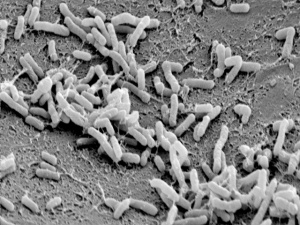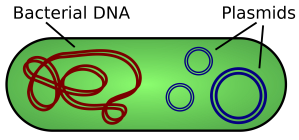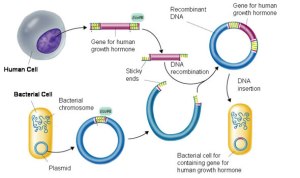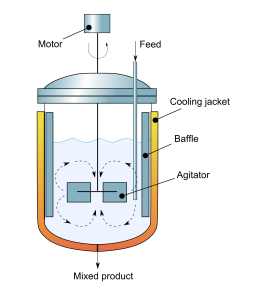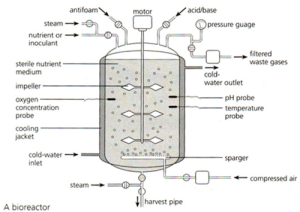Tagged: Bacteria
Bacteria and Yoghurt: Grade 9 understanding for IGCSE Biology 5.7
Biology is a great subject to teach: you get to introduce young minds to the wonders of the natural world, to show them how evolution has been able to take an ancient planet with a few self-replicating molecules in some deep sea vent and end up today with perhaps 100 million different species all occupying unique niches in an ever changing ecosystem. You can take students onto a journey into the cell so that they understand and appreciate the complexities of DNA as a coding molecule and how proteins have evolved to carry out the myriad processes of cellular biology.
And you also get to teach the role of bacteria in yoghurt making. This will be a short post.
This is yoghurt. It is made from milk.

Milk contains a sugar, lactose. Yoghurt is made when a culture of Lactobacillus bacteria is added to the milk. The two most important bacterial species involved in yoghurt making are called Lactobacillus bulgaricus and Streptococcus thermophilus (although only the former is mentioned in the specification). Perhaps they didn’t want the excitement levels to get too high….?
Lactobacillus use the lactose in the milk as a respiratory substrate producing lactic acid as a waste product. This lactic acid gives the yoghurt its bitter taste as well as lowering the pH so that the yoghurt takes on its gel like appearance.
Respiration in Lactobacillus:
Lactose ——> Lactic Acid
That’s the limit of my knowledge and interest in this topic: hope it helps…….

Genetically Modified Plants: Grade 9 Understanding for IGCSE Biology 5.15 5.16
You should understand how bacteria can be genetically modified to produce useful proteins (e.g.human insulin, human growth hormone, vaccine antigens etc.) – see previous post if you are unsure. In this post, I will try to explain how transgenic plants can be made and indeed what kind of genes might be added to plants to benefit humans. Genetically modifying a plant will be a more complex process since plants are multicellular and so many millions of cells need to be genetically altered.
Luckily a vector exists that can transfer genes into many varieties of plant. Agrobacterium tumefaciens is a species of bacterium that contains a plasmid that can be transferred into plant cells. This plasmid (called the Ti plasmid) can be cut open with a restriction enzyme and a new gene inserted with DNA ligase.

The Agrobacterium that have been genetically modified will then infect the plant tissue and then when this plant tissue is cultivated using the micropropagation techniques you learned about with cauliflower, a whole GM plant can be produced.
Genes can also be inserted into plants by a gene gun. A gene gun literally fires “bullets” made of tiny particles of gold that have been coated with the required DNA and while Agrobacterium does not infect all species of plant, the gene gun can work to get foreign DNA into any plant species.
What are the potential advantages of GM crops?
Resistance to Herbicide: some crop plants have been altered so they contain a gene that makes them resistant to a particular herbicide. This means a farmer can spray the herbicide on his crop without risk of harming the crop plant.
Resistance to Frost: some GM plants have a gene from a species of Arctic fish that codes for an “antifreeze” chemical in the fish blood. Plants that contain this gene will be frost-resistant and so produce can be transported in refrigerated containers without damaging the plant cells.
Golden Rice: rice plants have been altered so they contain genes that make the molecule beta-carotene. This is the orange pigment found in carrots and is a precursor for making vitamin A. So in populations who rely on rice as a staple component of their diet, the rice will be more nutritious and so prevent the night-blindness associated with vitamin A deficiency.
Antibody production: plants may also be genetically modified to produce antibodies for treatment of human disease.

Recombinant DNA: Grade 9 Understanding for IGCSE Biology 5.12 5.13 5.14
In the last post on this topic, I explained about the two types of enzymes needed for the genetic modification of organisms:
Restriction enzymes that can cut up DNA molecules at specific target sequences, often resulting in fragments with sticky ends
DNA ligase that joins together fragments to form a single DNA molecule
The EdExcel iGCSE syllabus uses the example of the genetic modification of bacteria to produce human insulin. Human insulin is a hormone that helps regulate the concentration of glucose in the blood. It is made in the pancreas when the blood glucose concentration gets too high and causes liver cells to take up glucose from the blood and convert it to the storage molecule glycogen. Patients with type I diabetes cannot make their own insulin and so need to inject it several times a day after meals to ensure they maintain a constant healthy concentration of glucose in their blood.
Bacteria can be genetically modified so that they produce human insulin. These transgenic bacteria can be cultured in a fermenter and the insulin produced can be extracted, purified and sold.
How do you get hold of the human insulin gene?
Well the honest answer is that there are a variety of ways of achieving this. It can now be synthesised artificially as we know the exact base sequence of the gene but it can also be cut out of a human DNA library using a restriction enzyme. There are other ways too but for the sake of brevity (and sanity) I am not going to go into them here. [If you are really interested in this, find out how reverse transcription of messenger RNA from cells in the pancreas can allow you to build the insulin gene.]
How do you get the human insulin gene into a bacterium?
Remember that bacterial cells are fundamentally different to animal and plant cells. One difference is that bacterial cells have no nucleus and their DNA is in the form of a ring that floats in the cytoplasm. Many bacteria also have plasmids which are small additional rings of DNA and these provide a way for getting a new gene into a bacterium.
Bacteria exchange plasmids in a process called conjugation and so it is fairly easy to get the plasmid out of the bacterium. If the plasmid is cut open using the same restriction enzyme as was used to cut out the human insulin gene, the sticky ends will match up and so DNA ligase will join the two pieces of DNA together to make a recombinant plasmid. The diagram below shows the process for human growth hormone but it would be exactly the same for the example we are looking at.
If the recombinant plasmids are inserted into bacteria, the bacteria will read the human insulin gene and so produce the protein insulin.
How do you grow the transgenic bacteria on an industrial scale?
The bacteria that have taken up the recombinant plasmid are grown in a fermenter. This is a large stainless steel vat (easy to clean and sterilise) that often has several design features conserved between different varieties:
The fermenter usually has a cooling jacket to carry away excess heat. The jacket often has a cold water input pipe and the warmer water is carried away. There has to be some mechanism for mixing the contents of the fermenter so the diagram above shows paddles attached to a motor. Fermenters also need a sterile input system for getting air, water and nutrients into the fermenter but without introducing foreign bacteria and fungi. Air is needed as the bacteria are aerobic and need oxygen for respiration.
If the bacteria in the fermenter contain the human insulin gene, then they will be able to produce human insulin. This can be extracted, purified and sold to the NHS for treating type I diabetics.

Genetic Modification Grade 9 Understanding for IGCSE Biology 5.12 5.13 5.14 5.16
One of the most complicated areas in the iGCSE course is looking at how organisms can be genetically modified. Remember that humans have been messing around with the genetic composition of many species for thousands of years. Up until recently this has only been using a technique called selective breeding or artificial selection.
Make sure you understand exactly what is meant by the term selective breeding? You probably should be able to explain at least one example in both an animal and a plant species.
In the twentieth century scientists developed a much more precise way of genetically modifying a species. This was due to discoveries about the nature of the genetic code and also the existence of two types of enzyme that make cutting up and then sticking together pieces of DNA. This new technique was called genetic engineering and it has two big advantages over selective breeding. Firstly genes from different species can be recombined to form transgenic organisms. Transgenic is an important term and means an organism that contains DNA from more than one species. This means scientists are not restricted to alleles present in the natural population but can insert genes from any species into any other. Secondly, selective breeding has a big disadvantage in that it can reduce the allelic diversity in a population. If the population becomes more and more similar at a genetic level, this means that inbreeding becomes more of a problem and the population becomes susceptible to damage from changes in the environment.
You need to understand the role of two enzymes in the process of Genetic Engineering:
Restriction Enzymes are found in bacteria and have evolved to combat viral infection in the bacterial cell. These enzymes can cut double-stranded DNA at a specific target sequence, often leaving the ends of the DNA with short sections of unpaired bases. These are called sticky ends.
The image below shows the cutting site of a restriction enzyme called EcoR1. You can see the enzyme cuts the DNA anywhere the following sequence is found GAATTC. The DNA molecule is cut after the first G, leaving the two strands with four unpaired bases that make up the two sticky ends.
Here are some more restriction enzymes and there target sequences. The bottom three on the list all produce sticky ends.

The second important enzyme for genetic engineering is DNA Ligase. This enzyme catalyses the joining together of the sticky ends of two fragments to produce an intact DNA molecule.
The starting point for understanding the complex topic of genetic modification of organisms is understanding the role of these two enzymes in the process.
Five Kingdom classification – Grade 9 Understanding for IGCSE Biology 1.2 1.3
The specification has a section called “Variety of Living Organisms”. In this section, candidates are asked to learn about the features of the Five Kingdoms of living things and certain examples are mentioned. This model of grouping organisms states that all living things can be allocated to one of these five groups:
- Bacteria (Monera)
- Animals
- Plants
- Fungi
- Protoctists (Protista)
It is disappointing that Viruses are added as a sixth group in this section of the syllabus. Viruses are not classified as a Kingdom of living things as they are not made of cells and have no metabolism.
Bacteria
Bacteria are small, single celled organisms that are made of a fundamentally different kind of cell to all the other Kingdoms. Bacterial cells are described as being prokaryotic: they are smaller than other cells, have no nucleus and no membrane-bound organelles (such as mitochondria or chloroplasts). Bacteria cells have a cell wall containing a cell membrane but their cell wall does not contain any cellulose. Instead the bacterial cell wall is made mostly of a molecule called proteoglycan a molecule is only found in bacterial cells.
Bacteria cells contain DNA (all living things use this molecule as their genetic material) but the key idea is that bacterial DNA is not contained inside a nucleus. Bacterial DNA is in the form of a single circular ring that just floats around in the cytoplasm of the cell. This circular ring of DNA is sometimes called the bacterial chromosome (but I dislike this term as the DNA molecule in bacteria is not wrapped around a scaffold of protein as in eukaryote cells). Some bacteria contain small additional rings of DNA that are called plasmids. These plasmids can be transferred from one bacterial cell to another, and can also be used as a vector in genetic engineering.
Examples of bacteria mentioned in the specification are Lactobacillus bulgaris a rod–shaped bacterium used in the production of yoghurt and Pneumococcus, a spherical bacterium that is the pathogen that causes the infectious disease pneumonia.
Remember that some bacteria are autotrophic and can carry out photosynthesis but most feed by absorbing material through their cell walls.
Animals
Animals by definition are multicellular organisms. Animal cells do not have a cell wall and do not contain chloroplasts and so cannot photosynthesise. Animals are often able to move from place to place and have a nervous system. Animal cells can store carbohydrate in liver and muscle cells in the form of a storage polysaccharide called glycogen.
The examples of animals mentioned in the specification are humans, housefly and mosquito.
Plants
The plant kingdom also contains organisms that are multicellular. In contrast to animals, plant cells do photosynthesise and do contain chloroplasts. Plant cells have a cell wall made of the polysaccharide cellulose. Carbohydrates are stored in plant cells in the form of starch and are transported in the phloem as a sugar called sucrose.
The examples of plants mentioned in the specification are maize, peas and clover. Maize is a wind-pollinated flowering plant and peas and clover are interesting because they are leguminous plants. If you remember your work on nitrogen-cycle from E summer, you will know that leguminous plants contain root nodules that contain nitrogen-fixing bacteria.
Fungi
Fungi are a group of organisms that include moulds, mushrooms, toadstools and yeasts. They are made of cells with a cell wall made of chitin and a nucleus. Fungi do not photosynthesise and do not contain chloroplasts. They feed by secreting digestive enzymes onto the food material they are living on and then absorbing the products of digestion: a process called saprotrophic nutrition. Fungi store carbohydrate in the form of glycogen.
Multicellular fungi such as Mucor are often organised into a mycelium, a mesh of thread-like structures called hyphae. Each hypha is a structure containing many nuclei. Some fungi such as the yeasts used in the brewing and baking industries are single-celled.
Protoctists
This is the least interesting of the 5 Kingdoms (which is saying something…..) Protoctists are all single celled organisms but unlike bacteria they are made of eukaryotic cells: cells with a nucleus and organelles like mitochondria and chloroplasts. Some protoctists like Amoeba share many features with animal cells while others like Chlorella are more plant-like and contain chloroplasts to photosynthesise. Some protoctists are pathogenic for example Plasmodium, the single celled organism that causes the disease Malaria.
An Amoeba cell on the left and some Chlorella cells on the right.
Nitrogen cycle for IGCSE Biology: Grade 9 Understanding 4.11B
I will make a blog post on each of the three “cycles” you need to know about for iGCSE. By far the most complicated is the Nitrogen cycle, so we might as well start there….
The first bit of understanding you need to is be clear the difference between how energy moves through an ecosystem and how matter (i.e. atoms) are exchanged between organisms and their environment. Energy in the ecosystems moves in a linear flow: there is no recycling of energy. The energy comes in at one end (in the producers through the process of photosynthesis) and is ultimately all lost as heat to the environment through the process of respiration. There is no possible way energy can be recycled. The “circle of life” that students like so much from Disney certainly does not apply here…. People find this idea very difficult to appreciate. All the time students will tell me that the energy in dead plants and animals goes into the soil and is then absorbed through the roots of plants: “it’s the circle of life sir” they earnestly tell me. And in the words of the late, great Amy Winehouse, I say “NO,NO,NO”…
Matter on the other hand is recycled through the ecosystem. The individual atoms that make up your body (H,O,C,N,S etc.etc,) have all been in other organisms and indeed will be again in the future. You took them in through your food and use these atoms to build the molecules that make up your cells. But ultimately all these atoms will leave your body either through metabolic processes or when you die and are decomposed. You could draw up a cycle for any of the atoms that are found in living things but your specification only requires you to understand two. How are carbon atoms cycled – the Carbon cycle – and how are nitrogen atoms cycled – the Nitrogen cycle. (You will also look at the Water cycle as well…..)
Things to understand about the Nitrogen Cycle:
1) Which molecules in living things contain nitrogen atoms?
Well the answer is fairly simple. Proteins are polymers of amino acids. Amino acids all contain an -NH2 group (amine group) and so Nitrogen is found in proteins. The bases in DNA (Adenine, Cytosine, Guanine and Thymine) are described as nitrogenous bases and so they contain nitrogen too.
2) Where are nitrogen atoms found in the ecosystem other than in the molecules of living organisms?
This is more complicated. Nitrogen gas makes up 78% of the atmosphere so clearly there is a lot of nitrogen in the air. In the soil, there will be urea from the urine of animals and urea contains nitrogen. There are also a range of ions found in the soil that contain nitrogen: the two most important are ammonium NH4+ and nitrate, NO3-. (I don’t know how to do subscript and superscript in WordPress and so you will have to excuse the rather ugly molecular formulae)
3) How do nitrogen atoms move from the abiotic (non-living) parts of the ecosystem and into the organisms?
There is only one way nitrogen atoms can move from the abiotic environment and into the organisms in an ecosystem. This is via plants that can absorb nitrate ions from the soil in their roots. This is a slight simplification but it will do at the moment. Look at the diagram above and find the arrow that shows assimilation of nitrates from the soil into plants.
4) How many different kinds of soil bacteria are involved in cycling nitrogen?
You need to know about four different kinds of bacterial that live in the soil that play a role in recycling nitrogen. Use the diagram above and your notes to describe the role each of these organisms play in the cycling of nitrogen atoms in the ecosystem.
- Decomposers (Putrefying Bacteria)
- Nitrifying Bacteria
- Nitrogen-Fixing Bacteria
- Denitrifying Bacteria
I am off to have my supper: another post about these bacteria will appear here later tonight or tomorrow. Please don’t read it until you have tried to write down a paragraph on each of the four types of bacteria in the bullet point list above.



